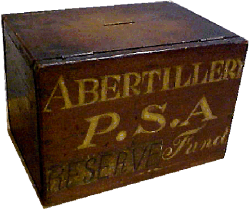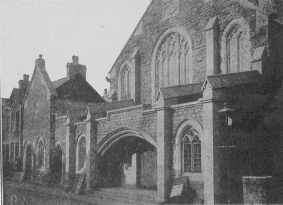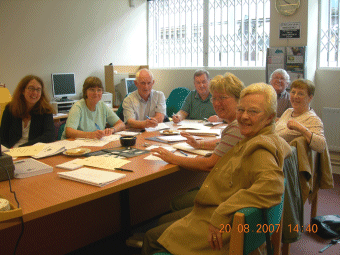Success Story!
The newly opened Museum has been popular with visitors, and a great source of pride for our members and all those involved in its refit. Don Bearcroft is busy arranging school visits for the coming term and judging by the response of our visitors to date, we are confident we have a venue which will continue to attract both old and young. The ‘Express Café’ is open for business during museum opening times and one of our next projects is to raise funds to buy café tables which will do justice to our wonderful marble café counter.
Fund raising August - £197
Diary Dates
Wednesday 5th September – Solemn Sabbaths and Faraway Sundays by Pete Strong
Wednesday 3rd October – A Journey up the Nile from Thebes to Abu Simbel by Don Bearcroft
Wednesday 7th November – From Camera to Canvas by Nora Lewis
Saturday 10th November – Christmas Bazaar, Ebenezer Chapel
Wednesday 5th December – 1804 Ship’s Surgeon by Roger Morgan
Lectures start at 7.00pm in the Metropole Theatre, with teas and a chat downstairs in the Museum afterwards. Entry is £2 and the public are most welcome. Details of coffee mornings etc are posted on the notice board at the Museum or at the following websites:
www.cwmtillery.com www.abertillery.net
Christmas Bazaar
This will be on Saturday 10th November at Ebenezer Chapel so can you please get busy with your arts and crafts and putting aside items for the usual range of stalls and attractions. Let’s make this a big success!
Lecture Programme
Marge Selway has put together a varied programme to start our new lecture season. First on the list is a talk with an intriguing title – Solemn Sabbaths and Faraway Sundays – but the speaker, Pete Strong, never fails to give a well researched and fascinating lecture. Please be sure to come along and bring family and friends. Remember that the lectures are now held in the Metropole Theatre, with tea and biscuits afterwards in the ‘Express Café’ in the Museum.
Bevin Boys
The Bevin Boys badge will feature a pithead design and profile of a miner. Those not eligible to apply for the badge include widows and those men who were already working as miners prior to 1939.
I was 17 years of age in 1939 so not conscripted, but some of my mates were, and those already in the Territorials were taken. When I was 18 years old I volunteered for the RAF without my colliery manager’s knowledge. Three days were spent at Penarth, South Wales, passing physical and educational tests before the colliery manager, Tom Griffiths, found out. I ended up before a panel of RAF officers who told me my manager was furious and demanding my return. So back to the pit to a ‘ticking off’.
I started work in the coalmines at 14 years of age. Originally my light was a candle, but on transfer to a gaseous mine it was a flame safety lamp. At 16 years of age in 1938 I was one of three miners selected to attend mining classes one day in a week of six working days and also to attend for three nights of night classes.
On return to Llanhilleth Colliery from Penarth, Tom Griffiths lectured me about after the war when men who returned would want their jobs and management to be there for them. So back to the coalface and also available as the St John first-aider for some 350 men in that coalface area.
I am sorry David Moody, Bevin Boy, was shocked to find his mine was pitch black, filthy and disgusting. I am proud of my lifetime in coalmines and my family heritage. I spent some of my 60s and 70s working for the B.E.S.O. charity trying to improve the lot of coalminers in the Philippines, Indonesia (Borneo) and Turkey. Described by Lord Truscott as a ‘survivors badge’, what about the 14 years to 50 and 70 year olds who, until miles of coalmine connecting roads were driven, risked being entombed underground if German aircraft bombed the pit headgears.
At the dedication of a war memorial in the front of our Workingmen’s Institute, I met with one particular war veteran who survived the war without injury. We discussed his two brothers; Frank the eldest lost both his legs in the war but he had been shocked by the injuries his youngest brother Tom had received underground at the age of 14 years – his survivor’s badge was a blue scar on his forehead across the whole temple. I was able to tell the brother that as a youngster myself I had splinted Tom’s fractures and dressed his wounds underground before taking him to hospital.
In conclusion: many men from the forces, with no experience of coal mining chose freely to come to work in the mines, some made it their careers. Many Polish warriors unable to go back to their own country embraced the work. Well done and good luck to the recipients of the Bevin Boys badge, some of you may already have our badges of blue scars.
W Arthur Lewis O.B.E.
The above letter was reproduced in part in the Daily Mail on June 27th 2007/
I know from conversations with some of our (male) Museum Society members, and husbands of members, that there are many mining stories to be told – more than are already recorded in the local history books the Museum has produced. Please let us have your recollections for the Newsletter. Jen Price
Poet’s Corner
QUIET AT RAMSHAW.
Grass grows tall at Ramshaw now, where once they smelted lead,
On hills around stand roofless buildings, of many an old pithead.
There too are tall stone chimneys,
that drew poison fumes from far below, But where so many toiled and laboured, grass grows tall at Ramshaw now.
On the valley sides are planted rectangular cloaks of evergreen,
To hide deep scars of mining
that show where man has been.
Many abandoned houses disappeared, Homes to they who worked the lead,
Where money earned in daily struggle, kept large families warm and fed.
That community quickly vanished,
when miners and smelters had to go, Where they once lived is open land, so grass grows tall at Ramshaw now.
Forsaken by all those working men, this valley knows peace supreme, Once again in the North Pennines, burbling burns are running clean.
Walkers and cyclists are safe,
where traffic volume is so low,
While in pollution free mountain air, grass grows tall at Ramshaw now.
Gordon Rowlands, July 2005
Congratulations!
Bishop Street Allotments have hit the headlines recently, winning yet another award and then having a visit by none other than Derek Brockway of BBC Wales. Our Assistant Curator Bernard Hill is a member of Bishop Street Allotments so we know who to contact for gardening tips!
Amy Pedwell, the grand-daughter of Museum Society members Jean and Cliff Hunt, is well known to music lovers in Abertillery, having sung and toured with the Abertillery Orpheus Male Choir. Amy was successful in winning the Gold Medal for the Open Solo competition at the Llangollen Music Eisteddfod recently. She has previously won medals at the National Eisteddfod and you will have an opportunity to hear her on 8th December at St Michael’s Church in Abertillery when she sings with the internationally known Polophonic Choir- a concert not to be missed.
Cliff Hunt -as well as his grand-daughter making the news, Cliff Hunt was himself featured in the local press recently when he was invited to the Mayor’s Parlour to be honoured for his services to bowling. Cliff began playing bowls in 1952 when he joined the Six Bells Club. He was clearly a natural and went on to win many prestigious competitions. He was the first bowler in Abertillery to win a Welsh Indoor International Cap in 1965 and has served as a Welsh team captain, President of Monmouthshire Bowling Association, and Chairman of the West Mon Bowls Association. As well as enjoying many individual and team successes over the years, Cliff has had the privilege of playing with many outstanding bowlers from the UK, including our ‘other’ Abertillery stars Teddy Jones and Sam Day.
The Metropole Theatre in Another Time
On Wednesday 19th March 1980, Abertillery and Blaina Rotary Club presented snooker in the Metrople Theatre. The star of the event was Mr Terry Griffiths who was Welsh Sportsman of the Year, a World Professional Snooker champion, and World Master Snooker Champion 1980. Terry Griffiths played local snooker enthusiasts and also gave an exhibition. Doug Mountjoy, another celebrity player, was also present and both signed a programme for Mr Arthur Lewis who recalls that Mr Griffiths returned £100 of his fee as a donation to Rotary Charity. The signed programme and a ticket have been given to the Museum.
The W.G. Vowles Organ at St Michael’s Church in Abertillery featured in an article last month. Here’s a little more.
Over the last fifty years a large number of traditional sounding organs in this country have suffered at the hands of those who admire continental sounds – in particular, the tinkling clarity of organs in North Germany and Scandinavia or the rasping excitement of the great organs of France. The firm of Vowles of Bristol always produced well-made instruments of refined and attractive tone but sometimes these qualities were at the expense of excitement. The organ at St Michael’s Church still boasts a large quantity of unaltered pipework, though modifications carried out some years ago added both useful and more alien tones. Recent work has reversed some of these changes, reconciling sounds that seemed at odds with each other, while adding further stops to give an organist the opportunity to render the great literature of other countries. The fact remains, this process is not complete but ongoing. The enlarged Vowles at St Michael’s Abertillery organ can sound both particularly beautiful and extremely rich and grand; all efforts to maintain and refurbish it should receive the fullest support.
Thanks to Glenys Lee for this article by Paul Derrett
Gwent Birds
No less than 289 bird species have been recorded in Gwent, including some less common species such as Red Kite (although these are seen more and more often) and the Mediterranean Gull with its starkly white plumage and red beak and legs. While some species thrive, others fail and the once common Tree Sparrow is now a very rare sight indeed. Local wildlife groups and Councils in Gwent have come together to try to help this threatened bird. Gwent Ornithological Society has recorded an 80% decline in its range in the period between 1981 and 2003. A ‘Spot the Tree Sparrow’ campaign has been launched to help this little bird recover its numbers. Seven key sites have been selected on the Caldicot Levels and Usk Valley areas and at each, winter feed and nest boxes for tree sparrows will be provided. Such measures are aimed at addressing the loss of winter stubble and other feeding opportunities due to changing agricultural practices and the shortage of suitable nesting sites. A similar scheme has helped raise numbers in Wiltshire so let’s hope our own Tree Sparrows here in Gwent are able to make a comeback, given a little care and attention.
Museum Matters
The new museum design has been opened and visitor numbers have increased tremendously.
This is due to the magnificent displays that are on show but there is another facet of the museum's work that the visitors do not see.
This is the highly important work of documentation. It is done by a band of volunteers on different days of the week suited to them and consists of cataloguing the items that are in our collection.
The procedure for documentation starts with the details of the item that is being donated to the museum entered into an Accessions form. After reading and agreeing to the accessions policy this is signed by the depositor stating they are legally the owner or authorised to do so by the owner. It is important at this stage to have as much information as possible about the object.
The next stages in the procedure is to give the form an accessions number which is entered into the accessions log, and the information entered onto a card. Two other cards are used for cross-reference; Classification and Donor indexes. Lastly it is entered into the computer database. The cards have as much information that is known about the artefact (this can be added to as we shall see) and also its present location which enables you to find an object. Now that we have all new cases and galleries we have the task of numbering the cases and altering the locations of the items on display.
It may seem a mundane task to some but it is one way of learning about the artefacts that are brought into the museum as well as those already deposited. It can be both rewarding and interesting when the provenance of an item is at best sketchy and at worst non-existent. This is where the detective work of those involved in documentation comes in.
 One instance of this is small box that was brought in, on it were the letters; P.S.A. we found out that they stood for Pleasant Sunday Afternoon and that these events were held in Somerset Street Methodist church. Recently Edwin Hackling gave us a copy of a booklet for the Somerset Street Methodist church. In it is a list of important dates one of these states that in 1909: P.S.A. Society was founded at Somerset Street. In another pamphlet is a poster advertising the services and the P.S.A for the weeks June 3rd and 10th. 1929.
One instance of this is small box that was brought in, on it were the letters; P.S.A. we found out that they stood for Pleasant Sunday Afternoon and that these events were held in Somerset Street Methodist church. Recently Edwin Hackling gave us a copy of a booklet for the Somerset Street Methodist church. In it is a list of important dates one of these states that in 1909: P.S.A. Society was founded at Somerset Street. In another pamphlet is a poster advertising the services and the P.S.A for the weeks June 3rd and 10th. 1929.

The large 1914 date stone outside the museum came from this church schoolroom.
Our documentation teams pride themselves in researching the correct information for the objects and photographs they are cataloguing. This work is carried out to a high standard was part of the reason our museum archived Full Registration.

Next year we will be applying for Accreditation this is a higher standard. Some museum volunteers involved in documentation have already  attended two courses about this scheme. The courses are run by the M. D.A. and given by Rachael Rogers the Curator of Abergavenny Castle Museum.
attended two courses about this scheme. The courses are run by the M. D.A. and given by Rachael Rogers the Curator of Abergavenny Castle Museum.
We always need volunteers so why and not come along join in the fun!
Don Bearcroft curator.


